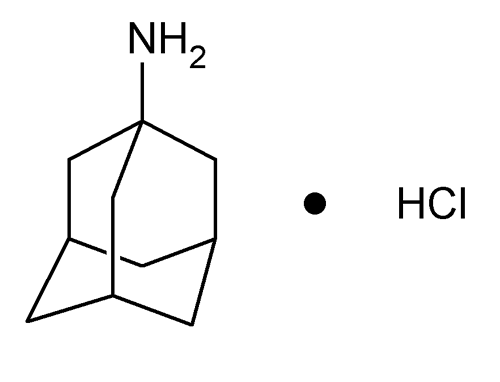Amantadine Hydrochloride
Tricyclo[3.3.1.1.3,7]decan-1-amine, hydrochloride.
1-Adamantanamine hydrochloride
» Amantadine Hydrochloride contains not less than 98.5 percent and not more than 101.5 percent of C10H17N·HCl.
Packaging and storage—
Preserve in well-closed containers.
Clarity and color of solution—
Dissolve 2 g in 10 mL of water: the solution is clear and nearly colorless.
Identification, Infrared Absorption  197S
197S —
—
Cell:
1 mm.
Solution—
Dissolve about 50 mg in 10 mL of 0.1 N hydrochloric acid, and filter. Transfer the filtrate to a suitable separator, add 1 mL of 5 N sodium hydroxide, and extract with 5 mL of methylene chloride.
pH  791
791 :
between 3.0 and 5.5, in a solution (1 in 5).
:
between 3.0 and 5.5, in a solution (1 in 5).
Heavy metals, Method I  231
231 —
Use 1 mL of 1 N acetic acid in the Test Preparation: the limit is 0.001%.
—
Use 1 mL of 1 N acetic acid in the Test Preparation: the limit is 0.001%.
Chromatographic purity—
Internal standard solution—
Transfer about 500 mg of adamantane, accurately weighed, to a 10-mL volumetric flask, dissolve in and dilute with dichloromethane to volume, and mix.
Test solution—
Transfer about 1.0 g of Amantadine Hydrochloride, accurately weighed, to a separator. Add 20 mL of 5.0 N sodium hydroxide and 18 mL of dichloromethane, and shake for 10 minutes. Remove the water layer, dry the organic layer by swirling with anhydrous sodium sulfate, and allow to stand for a few minutes to ensure that all remaining water has been removed. Filter, collect the filtrate in a 20-mL volumetric flask, add 0.2 mL of Internal standard solution, and dilute with dichloromethane to volume.
Standard solution—
Transfer about 10 mg of USP Amantadine Hydrochloride RS, accurately weighed, to a separator. Add 20 mL of 5.0 N sodium hydroxide and 18 mL of dichloromethane, and shake for 10 minutes. Remove the water layer, dry the organic layer by swirling with anhydrous sodium sulfate, and allow to stand for a few minutes to ensure that all remaining water has been removed. Filter, collect the filtrate in a 20-mL volumetric flask, add 0.2 mL of Internal standard solution, and dilute with dichloromethane to volume.
Chromatographic system (see Chromatography  621
621 )—
The gas chromatograph is equipped with a flame-ionization detector and a 0.53-mm × 30-m fused-silica column coated with 1.0-µm G27 stationary phase. The carrier gas is helium, flowing at a rate of about 4 mL per minute, and the split flow is about 200 mL per minute with a split flow ratio of 50:1. Initially, the temperature of the column is equilibrated at 70
)—
The gas chromatograph is equipped with a flame-ionization detector and a 0.53-mm × 30-m fused-silica column coated with 1.0-µm G27 stationary phase. The carrier gas is helium, flowing at a rate of about 4 mL per minute, and the split flow is about 200 mL per minute with a split flow ratio of 50:1. Initially, the temperature of the column is equilibrated at 70 for 5 minutes, then the temperature is increased linearly at a rate of 10
for 5 minutes, then the temperature is increased linearly at a rate of 10 per minute to 250
per minute to 250 , and maintained at 250
, and maintained at 250 for at least 17 minutes. The injection port temperature is maintained at 220
for at least 17 minutes. The injection port temperature is maintained at 220 , and the detector temperature is maintained at 300
, and the detector temperature is maintained at 300 . Chromatograph the Standard solution, and record the peak responses as directed for Procedure: the relative retention times are about 0.7 for adamantane and 1.0 for amantadine; the resolution, R, between adamantane and amantadine is not less than 20; and the relative standard deviation for replicate injections determined from the peak response ratios of amantadine to adamantane is not more than 5.0%.
. Chromatograph the Standard solution, and record the peak responses as directed for Procedure: the relative retention times are about 0.7 for adamantane and 1.0 for amantadine; the resolution, R, between adamantane and amantadine is not less than 20; and the relative standard deviation for replicate injections determined from the peak response ratios of amantadine to adamantane is not more than 5.0%.
Procedure—
Separately inject equal volumes (about 2 µL) of the Standard solution and the Test solution into the chromatograph, record the chromatograms, and measure all of the peak responses. Calculate the percentage of each impurity in the portion of Amantadine Hydrochloride taken by the formula:
100(Ri / RS)(WS / WU)
in which Ri is the peak response ratio of each impurity to adamantane obtained from the Test solution; RS is the peak response ratio of amantadine to adamantane obtained from the Standard solution; WS is the weight, in mg, of USP Amantadine Hydrochloride RS taken to prepare the Standard solution; and WU is the weight, in mg, of Amantadine Hydrochloride taken to prepare the Test solution: not more than 0.3% of any individual impurity is found; and not more than 1.0% of total impurities is found.
Assay—
Dissolve about 120 mg of Amantadine Hydrochloride, accurately weighed, in a mixture of 30 mL of glacial acetic acid and 10 mL of mercuric acetate TS, and titrate with 0.1 N perchloric acid VS, determining the endpoint potentiometrically, using suitable electrodes. Perform a blank determination, and make any necessary correction. Each mL of 0.1 N perchloric acid is equivalent to 18.77 mg of C10H17N·HCl.
Auxiliary Information—
Please check for your question in the FAQs before contacting USP.
Chromatographic Column—
| Topic/Question | Contact | Expert Committee |
| Monograph | Behnam Davani, Ph.D., M.B.A.
Senior Scientist 1-301-816-8394 |
(MDAA05) Monograph Development-Antivirals and Antimicrobials |
| Reference Standards | Lili Wang, Technical Services Scientist 1-301-816-8129 RSTech@usp.org |
USP32–NF27 Page 1504
Pharmacopeial Forum: Volume No. 31(5) Page 1344
Chromatographic columns text is not derived from, and not part of, USP 32 or NF 27.
